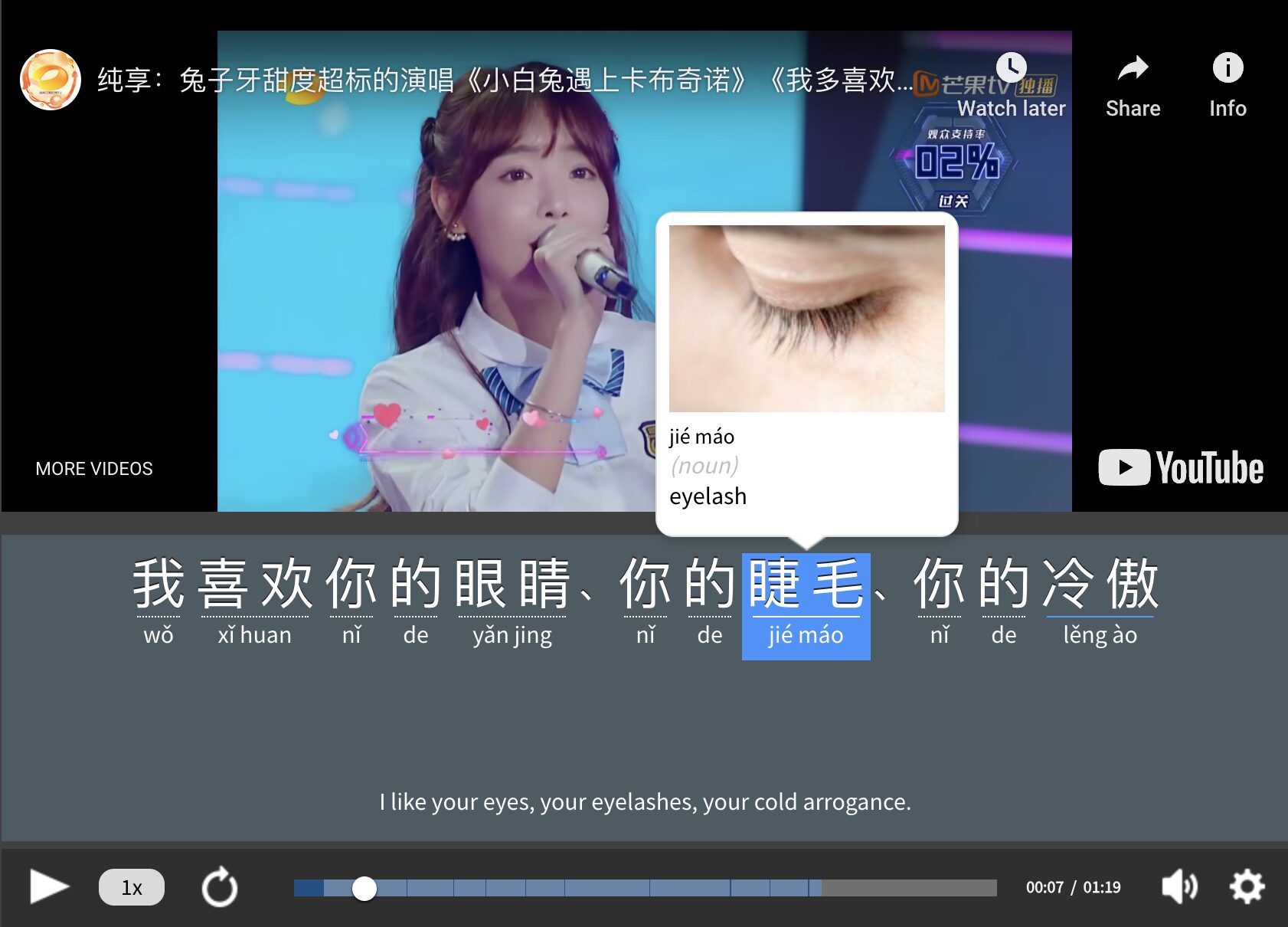Contents
- What Are the Chinese Tones?
- 1. Think about how your native language uses pitch
- 2. Practice hearing tones with one syllable, then in tone pairs
- 3. Identify tones when listening to native Chinese content
- 4. Practice pronouncing tones out loud
- 5. Work with a native speaker
- 6. Record yourself
- 7. Write the tones out
- 8. Say the tones with gestures
- 9. Slow down audio resources
- 10. Mark each tone with a different color
- 11. Use online resources for practicing tones
- And one more thing...
How to Practice Chinese Tones: 11 Tips to Master Pronunciation

Chinese tones are one of the biggest challenges beginners face when learning Chinese. They determine the meaning of words, so getting the wrong tone could mean saying the wrong thing.
But the good news is, you definitely don’t need to visit or be in China to master them. Let me show you exactly how to practice Chinese tones using 11 methods.
Download: This blog post is available as a convenient and portable PDF that you can take anywhere. Click here to get a copy. (Download)
What Are the Chinese Tones?
Mandarin Chinese is a tonal language, which means the tone you use when pronouncing a word changes its meaning.
There are five tones, and they’re represented by tone marks placed above the vowel that is being stressed or pitched a certain way.
- First tone (Flat)
- Second tone (Rising)
- Third tone (Falling-Rising)
- Fourth tone (Falling)
- Fifth tone (Neutral)
Here’s an example of tone marks, sounds and how the tones alter a word’s meaning:
To an untrained ear, these words can be hard to differentiate.
But luckily, there are several ways you can fine-tune your listening skills and learn to recognize tones easily.
1. Think about how your native language uses pitch
You may not be a native speaker of a tonal language, but all spoken languages use pitch to distinguish some sort of meaning. If you’re a native English speaker, the pitch of your voice conveys things like whether you’re asking a question or making a statement.
It also shows how sure you are of what you’re saying, and how you feel about it.
Try this: Say “yes” like you’re absolutely sure you mean it. Now say “Yes?” as if you’re not so sure.
Can you hear the difference? Now try doing the same thing, but instead of an English word, say it with a syllable like ma.
Now, click the words to hear how mà and má are pronounced:
骂 (mà)
麻 (má)
Do you hear a resemblance to what you just said? Listen again to the Chinese tones and think about what they sound like to you.
2. Practice hearing tones with one syllable, then in tone pairs
There are numerous recordings available that will let you listen to tones. But aside from tone tests in class and the odd one-syllable vocabulary word, you won’t often encounter solitary tones.
So I recommend that, as soon as possible, you move on to working on hearing tones in longer combinations—at least two syllables long.
Tones sound different in context than they do in isolation. The most dramatic example of this is third tone. Chinese textbooks universally teach you that the third tone is falling-rising. But—and this is really, really important—it’s only like that when you say it all by itself, or maybe at the end of a sentence.
In normal speech, the third tone is more often just a low tone.
If you spend too much time training yourself on one-syllable words, you may have a hard time hearing the difference between the second and third tones in context. (I might be speaking from experience on this one).
The best resources for this kind of listening practice—aside from a real, and very patient Chinese speaker, of course—are recordings of real people speaking words or sentences. You’re not trying to learn to speak to a computer, so don’t learn to listen from a synthesized voice.
Even tone-learning apps recorded by real people won’t help you learn what real speech sounds like if they rely on spliced-together syllables.
3. Identify tones when listening to native Chinese content
Use listening materials that force you to make a choice. Which tone was it that you just heard? This type of choosing—followed immediately by feedback—helps with learning.
Once you know where you consistently make mistakes, practice listening to those tones and then test yourself again. Eventually, I promise, your brain will begin to sort it out, and you’ll start hearing differences.
The best resources for this are podcasts with transcripts, YouTube videos with subtitles, articles with audio versions and programs like FluentU that add clickable subtitles to Chinese videos.
FluentU takes authentic videos—like music videos, movie trailers, news and inspiring talks—and turns them into personalized language learning lessons.
You can try FluentU for free for 2 weeks. Check out the website or download the iOS app or Android app.
P.S. Click here to take advantage of our current sale! (Expires at the end of this month.)
4. Practice pronouncing tones out loud
So you can hear the difference between all four Mandarin tones now, right? At least sort of, sometimes?
The next trick is to figure out how to say them yourself. If you can already hear the tones, you should know what you’re aiming for.
- Listen and repeat. Listening and repeating is a tried and true form of learning to say words in a new language. So don’t underestimate its effectiveness. Practice repeating after native speakers as often as you can.
- Speak slowly at first. When you’re first learning Chinese, you’re training yourself to make all sorts of new sounds. When you’re practicing on your own, slow things down so you can fit everything in. Once your mouth gets the hang of it, it won’t seem so impossible.
- Exaggerate. Use the full range of your voice. Pretend you’re a voice actor telling a story. Sing if you have to! Get your highs up high and your lows down low. You don’t want to sound like this forever, of course, but it may help you get going in the beginning. Oh, but that neutral tone? Don’t exaggerate it at all. In fact, think anti-exaggeration. Aim for short and quick and in the middle, and you’ll probably get it right.
5. Work with a native speaker
If at all possible, find yourself a native Mandarin speaker who’s willing to give you honest feedback on your pronunciation. Ideally, find someone who can explain what it is that you’re doing wrong—someone who can tell you that your low tone wasn’t low enough or that your rising tone didn’t really rise far enough.
If you’re having a tough time knowing what to do, or you feel like you get everything wrong, try starting with some simple mimicking—he or she says a word, and you copy it.
Sometimes, even though you think you can’t hear what people are doing, you can still mimic them correctly. And once you’ve got that down, you can work from there to build the correct habits.
You can find native speakers on language exchange apps like HelloTalk and Tandem, or online tutoring platforms like italki. You can check out our full, in-depth reviews of these apps here:
HelloTalk Review: Valuable Tool for Language Learners But Matchmaking Could be Improved | FluentU Language Learning
In this review of HelloTalk, we take an in-depth look at the language exchange app and scrutinize its best (and worst) features, including their social media-like…
italki Review: Excellent for Finding Affordable, High-Quality Online Language Tutors | FluentU Blog
Read this italki review to find out if this language tutoring platform will serve you well on your language learning journey! I’ll explain how it works, the pros and cons,…
Tandem Review: Well Designed Language Partner App Feels Tinder-esque but Helps Learners Connect | FluentU Language Learning
Read our full Tandem review if you’re ready to dive into the world of online language exchange. Before you take the plunge, take a look at this Tandem review to find out…
6. Record yourself
If you can’t find someone to work with, find recordings of a native Mandarin speaker instead. Then record yourself saying the same things and compare. (And put your hard work hearing tones to good use!)
If you’ve put in your time with your listening practice, you should be able to get some feel for whether or not you’re on the right track.
7. Write the tones out
Not only is listening to tones important but writing them out is too, as it makes remembering tone pairs a bit easier.
A great resource for learning how to use, write and understand tones and tone pairs is the Yoyo Chinese Pinyin Series on YouTube. These videos break down everything you could need to know about Chinese tones as well as how to properly study them.
Every Chinese learner should also bookmark this Yoyo Chinese Pinyin Chart. This user-friendly, simple chart has every type of pinyin you’ll ever use in the Chinese language. Any level of learner could use this chart, but it’s especially valuable for beginners.
8. Say the tones with gestures
For those who are just starting out, this strategy will keep your tone pronunciation in check. All you have to do is mimic the movement of the tone with either your finger or your whole hand, kind of like a conductor of an orchestra.
These are the gestures you can use as you’re reading characters with different tones:
- First tone (—): Draw a straight line above your head to keep your pitch high and level. Notice how characters in the first tone tend to sound longer than the others, so try to draw a longer line or draw the imaginary line slowly.
- Second tone (/): Draw a diagonal quickly from the bottom left to the top right to slightly increase the pitch of your voice.
- Third tone (V): Draw a “V” or a “U” as a guide to scoop or drop, and then raise your pitch.
- Fourth tone (\): Draw a diagonal quickly from the top left to the bottom right to add a hard stress to the pinyin.
- Fifth/Neutral tone (.): Draw a dot to keep the pronunciation short and succinct.
9. Slow down audio resources
Whether you’re listening to an audio course or clicking on the first YouTube video in Chinese you can find, slow the audio down so you can better identify tones (and, if you want to go the extra mile, repeat them out loud).
Podcasts are one of the best resources to use for this exercise, and you can always adjust their speed. In fact, there are plenty of podcasts specifically designed for Mandarin learners, such as the Slow Chinese podcast, where the speakers talk at a slower rate and use relatively simple vocabulary.
10. Mark each tone with a different color
For those visual learners out there, a mnemonic device that might help is color coding. When a text is composed of so many different characters and sentences, tones can be tough to keep up with.
To make sure you’re reading the text correctly, you can assign each tone a different color, marking each character with the corresponding tone to read the passage correctly and fluently.
Remember that this strategy might not work for everyone, so don’t spend time highlighting or marking characters if you don’t find this kind of visual aid helpful.
11. Use online resources for practicing tones
Unfortunately, I haven’t come across the absolutely perfect online resource specifically made for learning tones. However, here are a few that at least meet the minimal requirement of having real people and real speech.
- Sinosplice has a really useful set of recordings for the four tones in isolation, and then the four tones (plus neutral tone) in every possible combination. Use it when you want to listen to specific tones or pairs of tones.
- Pinyin Practice lets you quiz yourself on one or two-tone combinations and keeps track of how many you have right and wrong. This is the best resource I’ve found for testing yourself. Note that this one can take a bit of time for the activities to load, but once that’s done, you’re good to go.
- Arch Chinese also lets you quiz yourself on the four tones in isolation. I mention it here just because this gives you another person to listen to, and because they also have a pinyin chart with audio that you can use for practice when you just want to choose the pairs of sounds.
And there you have it—11 easy ways to train your English-hearing ear to identify and understand Chinese tones.
Consistently use these best practices and you’ll be on your way to better Chinese listening comprehension in no time.
Download: This blog post is available as a convenient and portable PDF that you can take anywhere. Click here to get a copy. (Download)
And one more thing...
If you like learning Chinese at your own pace and from the comfort of your device, I have to tell you about FluentU.
FluentU makes it easier (and more fun) to learn Chinese by making real content like movies and series accessible to learners. You can check out FluentU's curated video library, or bring our learning tools directly to Netflix or YouTube with the FluentU Chrome extension.
One of the features I find most helpful is the interactive captions—you can tap on any word to see its meaning, an image, pronunciation, and other examples from different contexts. It’s a great way to pick up vocab without having to pause and look things up separately.
FluentU also helps reinforce what you’ve learned with personalized quizzes. You can swipe through extra examples and complete engaging exercises that adapt to your progress. You'll get extra practice with the words you find more challenging and even be reminded you when it’s time to review!
You can use FluentU on your computer, tablet, or phone with our app for Apple or Android devices. Click here to take advantage of our current sale! (Expires at the end of this month.)











